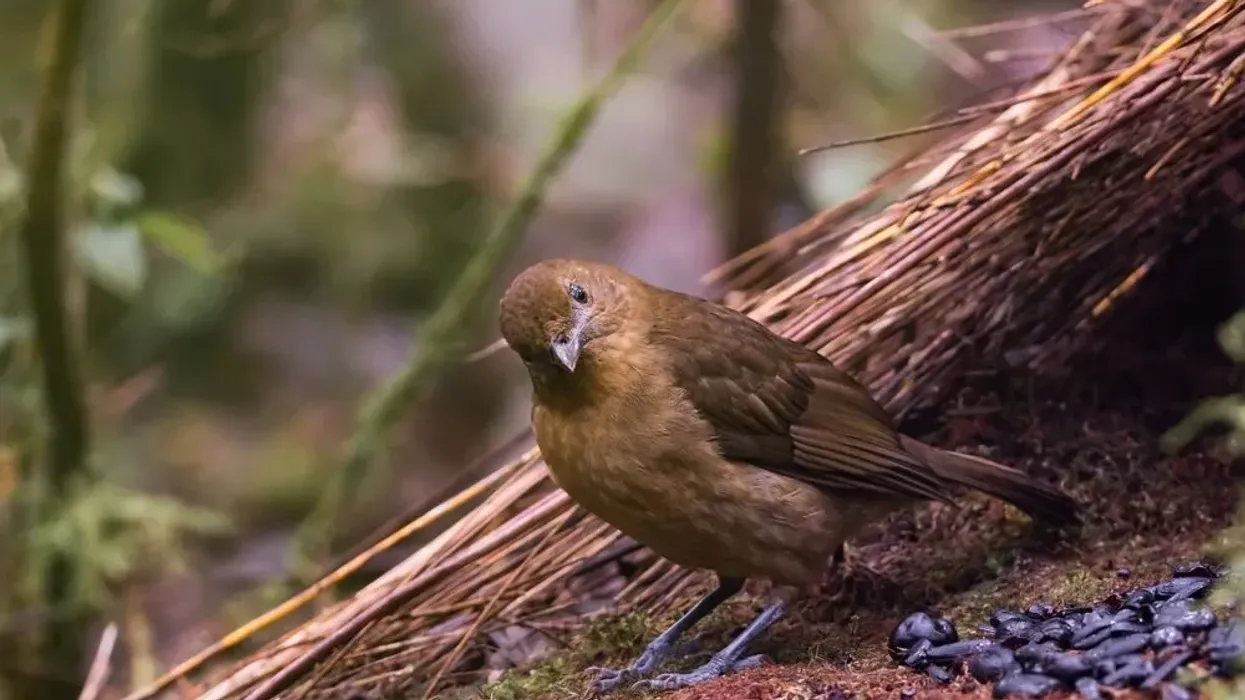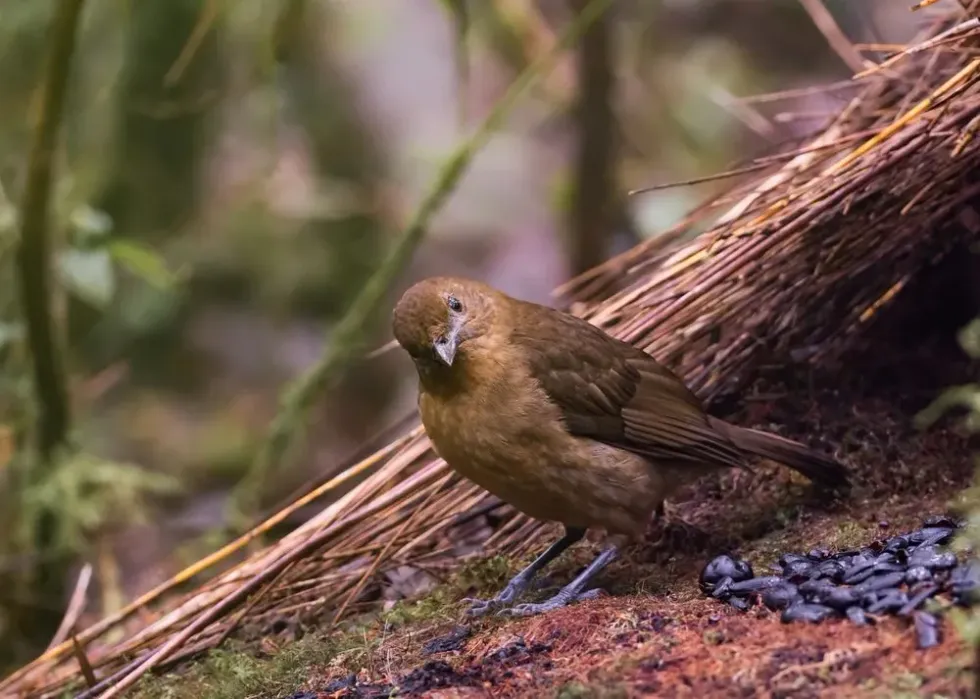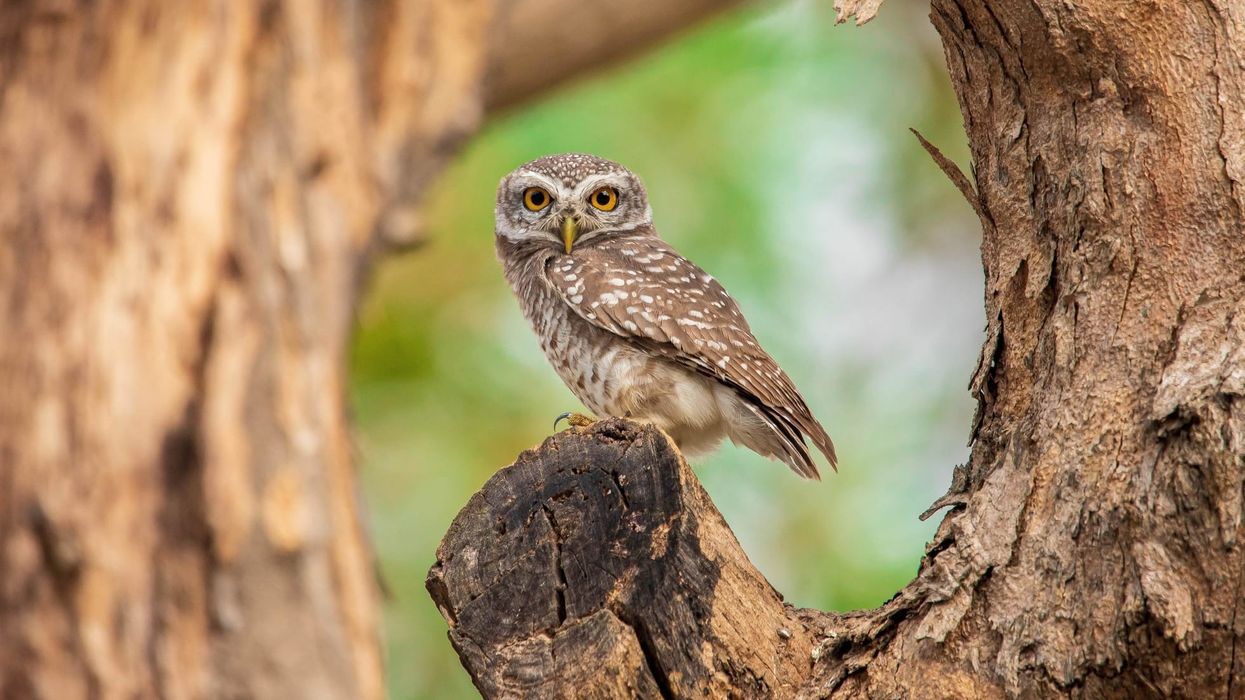The Vogelkop bowerbird (Amblyornis inornata) is also known by the name of Vogelkop gardener bowerbird. The birds are named after the Vogelkop Peninsula in Western New Guinea.
The scientific name of this uniformly brown species was derived from the Latin word for 'unadorned'. Bowerbirds as a whole are only found on the large island of New Guinea and also in Australia. The plain and dull color of these birds keeps them at a close distance from persecution.
The birds of the family Ptilonorhynchidae are known especially for the ability of the males to make a structure with colorful flowers and sticks for the purpose to attract the females to mate. The bowerbirds comprise 19 species in total.
Among these 19 species, almost 16 species have their males building beautiful bowers to attract their mate.
The name bowerbird is derived because of this courtship display by the male birds and none can match the elaborate designs made by the males of the dull-colored Vogelkop bowerbird. The colors used in the bowers are colors that both males and females of the Vogelkop bowerbird prefer.
There are over 9000 species of birds known to us. Some common species of these birds found all over the world are common tern and parrot. Read some fun facts about these birds only on the Kidadl website.
Vogelkop Bowerbird Interesting Facts
What type of animal is a Vogelkop bowerbird?
The Vogelkop bowerbird is a species of bowerbirds found in Indonesia.
What class of animal does a Vogelkop bowerbird belong to?
The Vogelkop bowerbird (Amblyornis inornata) falls under the class of Aves in the kingdom of Animalia.
How many Vogelkop bowerbirds are there in the world?
The population of the Vogelkop bowerbird is unknown. There is no immediate threat to the population numbers of this species.
Where does a Vogelkop bowerbird live?
The Vogelkop bowerbird is found exclusively in the mountains of the Vogelkop Peninsula in Western New Guinea in Indonesia.
What is a Vogelkop bowerbird's habitat?
The Vogelkop bowerbird is a species of bird found only in the mountains. They have a very limited range. In these habitats, the males are known to search around for the most beautiful ornaments for their tall architectures.
Who do Vogelkop bowerbirds live with?
The male is known to live solitary and is seen collecting ornaments for their bowers. The birds also feed alone. They are only seen in pairs during the mating season. One male is known to mate with many females in one season.
How long does a Vogelkop bowerbird live?
The research on the Vogelkop bowerbird is limited. The age is unknown for these birds. The Green Catbird and Satin bowerbird are the most researched birds of this family and are known to live for 8-10 years. There have been cases of these birds living for more than 20 years.
How do they reproduce?
The mating ritual of the Vogelkop bowerbird is quite unique. The male birds prepare beautiful cone-shaped hut-like architecture called bowers with flowers and sticks as a courting procedure.
The bowers of the Vogelkop bowerbird are carefully constructed by the males of the species with gathered twigs and objects like brightly colored stones, and fresh flowers. To make the bower more visually appealing, they use insect skeletons and place them in patterns. The nest is different than the bowers.
The birds live in the nest. The specially designed bowers are only to attract the potential mate of the male species.
Females build a nest on top of a loose foundation of sticks with leaves, ferns, and vine tendrils. After mating, females are seen in the nest looking after the eggs.
Not much research has been found on the number of eggs. Bowerbirds are known to lay a clutch of one to three eggs, but some species are seen laying only one egg. Males do not take part in the nesting or raising of the young.
What is their conservation status?
The conservation status of the Vogelkop bowerbird (Amblyornis inornata) is categorized as Least Concern by the IUCN Red List. There is no threat currently to the numbers of these birds. However, they have a limited habitat in the mountains of Western New Guinea in Indonesia and the population can be affected due to habitat degradation.
Vogelkop Bowerbird Fun Facts
What do Vogelkop bowerbirds look like?
The species of bowerbirds known as the Vogelkop bowerbird (Amblyornis inornata) is one of the dullest members of the bowerbird family. The coloration of these species of birds is usually olive-brown and has a paler coloration below.
The species have no ornamental plumage in the body.
They are medium-sized birds and the males of the species are slightly bigger than the females. These birds might have dull-colored bodies but they are known to make the most elaborate and decorative bowers in the species to attract their mate during the mating season.
The flame bowerbird is one of the most colorful bowerbirds. The birds are medium-sized and have a coloration of flame orange and golden yellow plumage with a yellow-tipped black tail.

* Please note that this is an image of a satin bowerbird, not a Vogelkop bowerbird. If you have an image of a Vogelkop bowerbird please let us know at hello@kidadl.com.
How cute are they?
These birds are considered pretty cute.
How do they communicate?
The native people in the mountains are well aware of the calls and mimicry skills of these birds. Bowerbirds are known to be superb vocal mimics. They are seen mimicking calls of other species. Some species are also seen mimicking pigs and human chatter.
How big is a Vogelkop bowerbird ?
The length of these bowerbirds ranges from 8.26-13.78 in (21–35 cm).
How fast can a Vogelkop bowerbird fly?
The speed of these birds is unknown.
How much does a Vogelkop bowerbird weigh?
The weight of the Vogelkop bowerbird ranges from 0.28-0.34 lb (127-154 g).
What are the male and female names of the species?
The male and female species of these birds are not given different names. They are known commonly as Vogelkop bowerbird (Amblyornis inornata) or Vogelkop gardener bowerbird.
What would you call a baby Vogelkop bowerbird?
A baby of the Vogelkop bowerbird is called a chick or a juvenile.
What do they eat?
Bowerbirds are known to feed on both plant and animal matter. Their diet consists of fruits, berries, new shoots, and insects.
Are they dangerous?
They are not dangerous at all.
Would they make a good pet?
Due to their limited range of habitat, it is not a good idea to consider these birds as pets. Also, they have specific requirements and conditions which cannot be made available at home.
Did you know...
The Vogelkop bowerbird (Amblyornis inornata) or Vogelkop gardener bowerbird is known for its ability to make beautiful bowers, which is also appealing to humans.
In history, there have been various studies that show that the Vogelkop bowerbird and all other species of bowerbirds are closely related to the family Paradisaeidae or birds of paradise. But DNA-DNA hybridization has placed these medium-sized species of birds close to the lyrebirds. The true relationship of these birds still remains unclear.
Satin bowerbirds collect blue because of their blue coloration. They need to show their color off.
Bowerbirds are often threatened by predators like feral cats and red foxes.
What is unique about bowerbirds?
Bowerbirds are known for their unique way of courtship. The males are known to create visually appealing bowers to attract females.
The male collects orange rhododendron flowers, yellow leaves, blue fruits, red ginger berries, iridescent blue beetle carapaces from nearby forests to make the bower. The male is known to arrange these objects according to size and color and take care of them as long as they live.
The male is known to invest a lot of time and patience to construct these bowers to attract females and is often seen rearranging the flowers and other items carefully. Two-column-like sticks make up the entrance to the bower and a front lawn can be seen free of debris and made with moss.
Flowers are used in the entrances too.
The more attractive the nest, the more chances of attracting a mate. Females visit multiple bowers to choose their partners.
Where do bower birds sleep?
When the bowerbirds are not feeding, they are found mostly in the bower, waiting for their mates and scaring off their rivals. Bowers are actually not nests. The males are known to sleep in the bower itself, while the females might sleep in the nest they make after breeding.
Here at Kidadl, we have carefully created lots of interesting family-friendly animal facts for everyone to discover! Learn more about some other birds from our Japanese quail facts and hermit thrush facts pages.
You can even occupy yourself at home by coloring in one of our free printable Vogelkop Bowerbird coloring pages.








